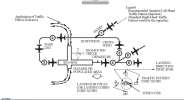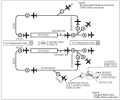So I take off in my c150 on rwy 5 and announced I'd be doing a left downwind departure to the west. a cirrus calls 8 miles out to the east and says he'll be entering the left downwind for rwy 5. I turn crosswind and he reports 3 miles out. as I turn downwind he calls "I'm entering downwind for rwy 5 coming in hot". I call and ask if he has me in sight. he says no and I hope I don't run into you...are you in your little 150? I am showing him 300 ft above and about a mile behind me. I felt it was too close for comfort so I descended another 200 ft to stay below him (now only 500 ft agl in the pattern) until I saw him turn base on adsb before I climbed to 4500 and exit the area.
not cool me thinks.
My critique, I have very little to criticize for either pilot here. I thought both did a pretty good job. Short version "communicate a bit better".
The criticism...
The Cirrus, ...coming in Hot(Fast) isn't cool but if descending and misjudged the descent it might be hard to slow down, and if I am not seeing any conflict I would probably continue...
... the "hope I don't run into you" comment was uncalled for, if I showed the other airplane a mile ahead of me and 300 feet below I would be looking and slowing down (perhaps not a easy option) and perhaps stayed a bit wide, on the downwind. I would expect a 150 to be pretty close into the pattern, but also might exit on the 45 (not something I normally do, but I watch pilots do it) and I would have been planning a slightly wider pattern anyway in the Cirrus especially if I was still a bit fast.
... He could have advised what he was doing to avoid, but if he saw you on ADS-B and knew you were ahead and below, he may have felt he was going to get slowed down and stay above you or to the side well enough.
The op ... Not much to criticize other than don't get upset about it, We are naturally problem solvers, you got to make some decisions to ensure the safety of both aircraft. Posting here is great in that reviewing it is how we get better. Most everyone is doing the best the can. Few are trying to be As-----es about it. And once in a while we are the As-----le, even if we don't mean to be.
... Once you realized he went 5 miles are just a couple minutes, and he was 3 miles as you were about 1/2 mile from the downwind, and you didn't see him yet. Try to deconflict hear might have helped while you still have a chance to see him. "Cirrus, I will precede north bound on the Cross wind until I have you in site", This way you he would be in as blind of a spot and would have let him come inside of you "
... Probably should have advised the Cirrus of your "evasive" maneuver so he could anticipate this. I have many times seen pilots do evasive maneuvers for aircraft they can't see, just to Maneuver right into the path of the other traffic.
He could have figured you were departing and would continue climbing so he might have descended to come in underneath you.
The Kudos....
The Cirrus ... He did exactly what he said he was doing and informed you of his situation and intentions. "entering down" I would assume this means entering downwind probably something close to a straight in. The 8 miles out even at 180kts this would be a 2+minute warning. If you think that isn't enough just stop here and wait 2 minutes before continuing reading.
... He responded to your crosswind call and acknowledged he knew you were there, even if he was a bit snarky about it.
The OP ... can be forgiven for thinking 8 miles out was enough for you to turning crosswind before seeing or identifying where he was, And you recognized this error promptly. At probably a more typical 120kts that's four minutes out. As a reference I figure I can do a pattern circuit about every 6 minutes.
... you also were making radio calls and acknowledging you heard and were looking for the other traffic.
... you identified the potential threat of him coming up behind you and performed a reasonable modification to your exit. I would have looked at the ADS-B track to see if a 45 degree exit would have also got me out of his way. But is also a good possibility that might have put you right on his flight patch. Again communication here would have helped.
Of course this I all Monday Morning Quarterbacking.
Over all, Handled well is my opinion.
Brian
CFIIG/ASEL





